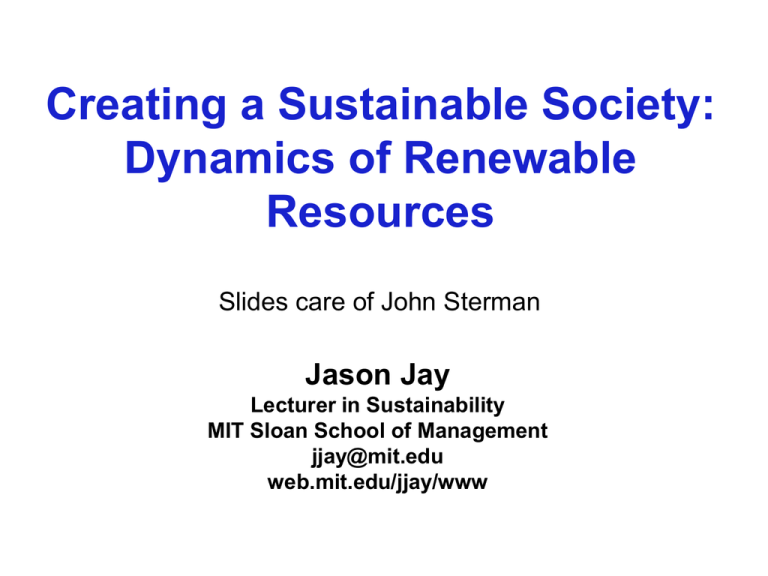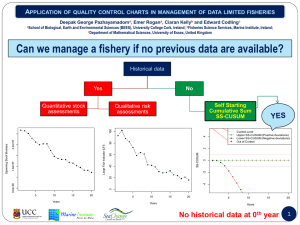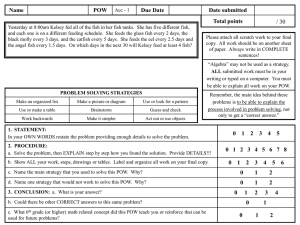File - MIT SEPT 2013
advertisement

Creating a Sustainable Society: Dynamics of Renewable Resources Slides care of John Sterman Jason Jay Lecturer in Sustainability MIT Sloan School of Management jjay@mit.edu web.mit.edu/jjay/www Fishbanks Debrief Winslow Homer, Fishing Boats, Key West (1903) “The Tragedy of The Commons” Garrett Hardin. Science 1968; 162:1243-8. G. Hardin, 1915-2003 Photo: 1986 The Tragedy of the Commons “Each man is locked into a system that compels him to increase his herd without limit—in a world that is limited. Ruin is the destination toward which all men rush, each pursuing his own best interest…” “No technical solution can rescue us.…” “We may well call it ‘the tragedy of the commons,’ using the word ‘tragedy’ as the philosopher Whitehead used it: ‘The essence of dramatic tragedy is not unhappiness. It resides in the solemnity of the remorseless working of things.’ “Common Pool Resources” • • • • Limited Stock Limited Rate of Renewal Easily Appropriable (Low barriers to access) Rival (What you use, I can’t use) EXAMPLES: • • • • • • Pastures Fish Forests Irrigation Clean Air & Water Climate • • • • • Roads and Highways Parking Spaces Views Server Resources Trust among consumers The Iceberg A Metaphor for Systems Thinking Events More Leverage Patterns of Behavior Systemic Structure Event level: the Headlines Codfish depleted off Maine Limits may follow as cod diminishes in Gulf of Maine Restrictions could Hurt local fishermen Lobstermen Snag record 38m pounds Fishing banned at Georges Bank Local fishermen fear overcrowding Hearing casts fishery as sinking ship Loopholes found In fishing rules N.E. lawmakers seek boat buyback ideas Feds approve boat buyback program Hope to thin fishing fleet with $2m in incentives Canada’s Gunboat Diplomacy Chrétien to protect Atlantic fish stocks Typical Game Behavior Catch Fish Ships 0 1 2 3 YEAR 4 5 6 7 Typical Game Behavior - Fleet Typical Game Behavior - Catch Typical Game Behavior - Fish Stocks Pattern #1: Overshoot and Collapse 4 12 3 2 1 0 1950 16 Thousand Metric Tons/year Thousand Metric Tons/year 5 Pacific Bluefin Tuna Catch Atlantic Swordfish Catch 8 4 0 1960 1970 1980 1990 2000 1950 1960 1970 1980 1990 2000 North Sea Herring Catch Mark Wise, Common Fisheries Policy of the European Community, New York, Methuen, 1984. Consider the Cod • Northern or Atlantic Cod –Long-lived, slow to mature –Once immensely abundant • Early fishers (e.g., Basque) claimed fish so dense you could walk from Spain to the New World on their backs. • John Cabot, exploring Newfoundland in 1497, noted fish so thick they practically blocked his ship. –Harvest ≈ 250,000 metric tons/yr through 1950s –Vital in feeding the Old World, in the development of the New World, …and of Massachusetts: The Sacred Cod Massachusetts State House Prevailing Mental Model: Unlimited Abundance “Probably all the great fisheries are inexhaustible; that is to say that nothing we do seriously affects the number of fish.” – Thomas Henry Huxley, 1883 Source: US National Marine Fisheries Service Estimated Cod Stocks, Scotian Shelf (000 Metric Tons) Estimated Biomass in 1852 1200 Estimated Carrying Capacity (Myers et al. 2001) 800 400 Total Cod Biomass Total Cod Biomass Age 5+ 0 1850 1870 1890 1910 Rosenberg et al., Frontiers in Ecology, 2005 1930 1950 1970 1980 Overshoot and Collapse Annual fish catch Why the pervasive pattern of overshoot and collapse of fisheries? Where are the leverage points for creating a sustainable fishery? Where are they not? Time The Iceberg A Metaphor for Systems Thinking Events More Leverage Patterns of Behavior Systemic Structure + + + Revenue + Price of Fish Fisher Profit Investment B - DELAY Costs + Operating Costs R Profitable Growth Fleet + + Total Catch + Catch per Ship + + + Fisher Profit Investment B - DELAY Costs + Operating Costs Revenue + + R Profitable Growth Price of Fish Fleet + Total Catch + Fish Stocks + Net Fish Fertility Ocean Carrying Capacity for Fish B + Catch per Ship No Fish, No Catch R DELAY + Regeneration + B Fish Density + Population Growth + R Economic Growth + R Population + Wealth + + + + Demand for Fish Fisher Profit Investment B - DELAY Costs + Operating Costs Revenue + + R + Profitable Growth Price of Fish Fleet + Total Catch + Fish Stocks + Net Fish Fertility Ocean Carrying Capacity for Fish B + Catch per Ship No Fish, No Catch R DELAY + Regeneration + B Fish Density + + DELAY Population Growth + R Economic Growth + R Population + + + Wealth + + Demand for Fish Technical Innovation Fisher Profit - Costs + + Profitable Growth Price of Fish Fleet + Total Catch Technology Race + Fish Stocks + Net Fish Fertility Ocean Carrying Capacity for Fish B + B + Catch per Ship No Fish, No Catch R DELAY + Regeneration + Fleet Productivity R + R + + DELAY Operating Costs Revenue DELAY Investment B Fish Density + Collective Action Elinor Ostrom: Winner, 2009 Nobel Memorial Prize in Economic Sciences “Common Pool Resources” • • • • Limited Stock Limited Rate of Renewal Easily Appropriable (Low barriers to access) Rival (What you use, I can’t use) EXAMPLES: • • • • • • Pastures Fish Forests Irrigation Clean Air & Water Climate • • • • • Roads and Highways Parking Spaces Views Server Resources Trust among consumers Rule-Base for Alanya • • • • List of eligible fishers each September List all usable fishing spots Assign spots by lottery – one per fisher September – January: Each day each fisher moves east to next spot • January – May: Each day each fisher moves west to next spot Design Principles for “Governing the Commons” • Individuals know the boundaries and limits – Of the resource (“Common Pool Resource”) – Of the community of users (“Appropriators”) • • • • • • Rules are locally made and adapted to context Decisions are made together Active measurement and monitoring Effective, graduated sanctions Accessible mechanisms for conflict resolution Latitude from higher authorities to act locally Teaching Resources • MIT Sloan Learning Edge • https://mitsloan.mit.edu/LearningEdge 1. Renewable resources can be used no faster than the rate at which they regenerate. Regeneration Resource Available Consumption 2. Pollution and wastes can be emitted no faster than natural systems can absorb them, recycle them, or render them harmless. Waste Generation Pollution, Waste Recycling, Decay 3. Nonrenewable resources can be used no faster than renewable substitutes can be introduced. Resource Available Source: Herman Daly Consumption 1. Renewable resources Regeneration Renewable Resource Harvest 2. Pollution and wastes can be emitted no faster than natural systems can absorb them, recycle them, or render them harmless. Recycling, Decay Pollution, Wastes Waste Generation 3. Nonrenewable resources Nonrenewable Resource can be used no faster than renewable substitutes can be introduced. Nonrenewable Resource Extraction Source: Herman Daly (e.g., H. Daly (1990) Ecological Economics 2, 1). Human Activity Ecosystem Services can be used no faster than they regenerate. Planetary Boundaries Rockström, J. et al. (2009) A Safe Operating Space for Humanity. Nature 461 (24 Sept.) 472-475. Beyond the Limits Approaching the Limits Mental Models about the Environment The economy is the only consideration; There are no limits to growth Environmental inputs not needed for production: Q = f(K, L, T) Economy Economic output = function of capital, labor, and technology, With no need for energy, water, clean air, stable climate, or any other ecosystem services. Mental Models about the Environment Triple Bottom Line: Environment Society Economy Economic outcomes (firm profit, national income) only one consideration; important to consider impact of firm and national activities on social and environmental concerns. But: frames each of these domains as separate, in opposition. Mental Models about the Environment In actuality: Only one world, no boundaries (political, ideological, other) visible from space. Boundaries are “invisible fences in the mind” (Sterman 2002) Environment Society Economy Sterman, J. D. (2002). All Models are Wrong: Reflections on Becoming a Systems Scientist. System Dynamics Review 18(4): 501-531. Mental Models about the Environment The economy, society and environment are not in opposition. Economic activity is embedded in a social and political context, which in turn is embedded in the ecosystems of the world upon which all life depends. Destroy the environment and you destroy the economy. Environment Society Economy Another example Home Energy Costs Drive Housing Affordability 2003 to 2008 • Average Household Energy Costs 20022003: 3.5% of median income • Average Household Energy Costs 20072008: 8.5% of median income • Median Household Income: $60,000 • Increase in Annual Energy Costs: $3,000 Transportation Energy Cost • • • • • • Household miles driven/yr: 40,000 Miles/gallon: 20 Gallons consumed: 2,000 2002-2003 price: $1.50/gallon 2006-2008 price: $3.50 Increase in costs per household: $4,000/yr The Result: Economic Meltdown • American families saw a 15% drop in after-tax income • This was the only substantial change to the economy • $583 per month drop in disposable income • Any homeowner on a tight budget was pushed over the edge The Result: Housing crisis, then economic meltdown due to housing-based financial products Quarterly U.S. All Grades Conventional Retail Gasoline Prices (Cents per Gallon) Mortgage Payments Past Due 60-89 Days: United States (SA, %) 2.00 1.50 1.00 0.50 1 19 Q 95 1 19 Q 96 1 19 Q 97 1 1 Q 998 1 19 Q 99 1 20 Q 00 1 20 Q 01 1 20 Q 02 1 20 Q 03 1 20 Q 04 1 20 Q 05 1 2 Q 006 1 20 Q 07 1 20 Q 08 1 20 Q 09 1 20 10 0.00 Q Q 1 1 Q 995 1 1 Q 996 1 1 Q 997 1 1 Q 998 1 1 Q 999 1 2 Q 000 1 2 Q 001 1 20 Q 02 1 2 Q 003 1 2 Q 004 1 2 Q 005 1 2 Q 006 1 2 Q 007 1 2 Q 008 1 2 Q 009 1 20 10 500 400 300 200 100 0 Causes of Overshoot • Market failures Externalities Common Pool Resource (Tragedy of the Commons) • Long Delays in Changes in Resource level Measuring resource level Understanding causes Recommending action Implementing policies Policy impact (Physical/Biological delay) (Perception delay) (Research delay) (Political/social delay) (Political/social delay) (Physical/Biological delay) Note: Delays are partly physical and partly political and social. Those with vested interests in the status quo often misrepresent the situation to delay action (e.g. tobacco, lead in gasoline, toxics in food, climate change). Causes of Collapse Collapse of the carrying capacity can occur when underlying resources are Nonrenewable or Renewable but Consumable or Degradable Collapse is worse with Slow or limited regeneration potential Tipping points created by positive feedbacks Irreversibilities due to e.g. Trophic cascade Evolutionary impacts Common pool resources (Tragedy of the Commons) World Population Growth November 2010: 6.88 Billion Net Increase today: ≈ 77 million/year Gross World Product, 1950-2008 Doubling Time ≈ 20 years At that rate, in 100 years GWP will be 32 times larger http://databank.worldbank.org Ave Growth Rate ≈ 3.5%/year In 2050, 9 Billion people would be driving 7.8 billion passenger vehicles, consuming 382 Million barrels of oil per day (> 5 times total world production today), emitting 60 Billion tons of CO2 per year (almost double total world emissions today), and taking up 143,000 sq. kilometers (an area the size of Bangladesh) just in parking spaces. * 2008 data Photo: J. Sterman If everyone lived like Americans do today* Possible Futures Human Activity Fluctuation around equilibrium Overshoot and decline S-shaped Growth: Smooth, gradual transition to equilibrium Time How will growth end? Growth in human activity cannot continue indefinitely. How will we make the transition? Voluntarily or involuntarily? Sustainably or unsustainably? What population? What standard of living? What quality of life? What degree of equity? What role for nature, other species? How robust to surprises? Growth Arises from Positive Feedback Adding the Carrying Capacity of the Environment: the Naïve Malthusian Carrying Capacity is Dynamic Carrying Capacity: Land Soil Fertility Material Resources Energy Resources Clean Water Clean Air Waste Absorption Capacity Favorable Climate Biodiversity Etc. We Alter the Carrying Capacity Technological Innovation The Impact of Delays Delays due to population age structure; slow adjustment of norms for family size & income aspirations; slow change in infrastructure & settlement patterns, etc. The Impact of Delays Delay in creating and testing technologies: Building research resources, knowledge base; developing ideas, testing and evaluation, commercialization & scale up, field testing, learning-by-doing, side effect evaluation & defect correction. Delays in perceiving environmental problems, building scientific consensus, political will, passing legislation; Delays in reaction of markets due to corporate opposition, inertia; time needed to reallocate resources and build research infrastructure. Delays lengthened by opposition of entrenched corporate & political interests (e.g,. CAFE standards, CFCs, climate change). The Impact of Delays Diffusion and deployment delays caused by long lifetimes of existing structures, infrastructure, plant and equipment Increased by organizational inertia, lock in to existing infrastructure, complementary assets, income inequality, intellectual property laws, local resistance to globalization. Delays due to physical processes in environment Examples: Ozone Depletion, Chlorinated Hydrocarbons accumulating up food chain, Global Warming. Technological Side Effects Technology is not always helpful or benign. Technologies designed to solve one problem often create others. Examples: DDT, Nuclear Power, Dams, automobiles, many others. The Precautionary Principle can reduce the risk of Harmful Side Effects from new technologies. But the PP entails long delays in the evaluation of new technologies and slow, gradual diffusion, weakening the Technological Fix feedback. Shortening the delays in the Technological Fix feedback to avoid limits to growth increases odds of harmful side effects. Self-reinforcing Collapse of Carrying Capacity? Loss of carrying capacity can compromise the ability of the environment to regenerate, leading to a vicious cycle that further erodes the carrying capacity. Examples: Overfishing, Albedo feedback and warming, desertification, ecosystem collapse Different Models, Different Futures Where is the leverage to create a sustainable world? Human Activity B2 Net Births Net Increase in Human Activity + + Net Investment Population + DELAY Productive Capacity DELAY Resource Prices, Social Concern, Gov't Policy - Population and Economic Growth - + B1 Involuntary Limits to Growth B5 Voluntary Limits to Growth Voluntary Limits Technology B4 DELAY Innovation + R1 Net Fractional Growth Rate Resource Consumption - DELAY + Technological "Side Effects" R3 Technological Nightmare DELAY - + + Consumption and Degradation Global Carrying Capacity Adequacy of Resources Regeneration and Restoration + DELAY Technological Solution B3 Regeneration R2 Environmental Tipping Points - + DELAY Regeneration Capacity + V& V PC &L STI I&S Socio-technical innovation I&R Scaled Solutions to Sustainability Challenges Strategies for Sustainable Business From: Porter & Kramer, 2006. “Strategy and Society.” Harvard Business Review. From: Porter & Kramer, 2006. “Strategy and Society.” Harvard Business Review. From: Porter & Kramer, 2006. “Strategy and Society.” Harvard Business Review.









